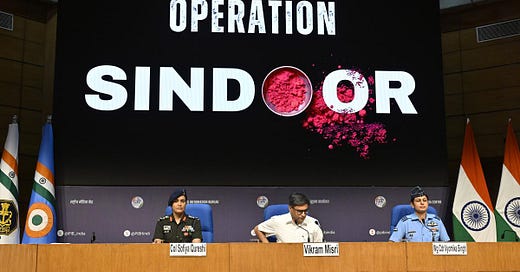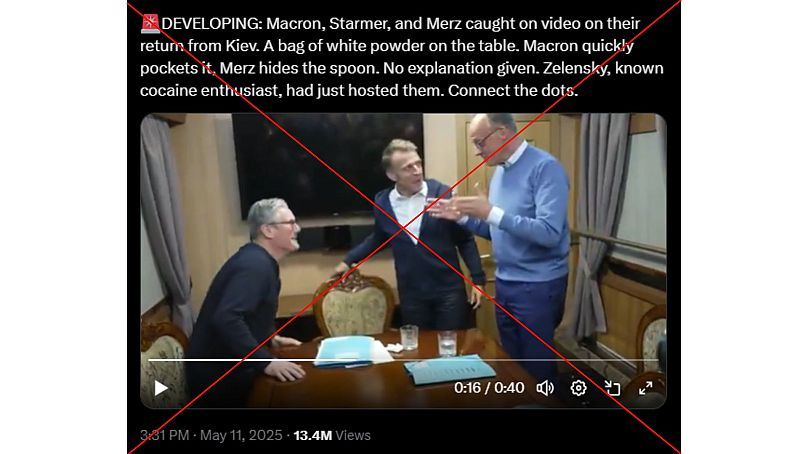Two major disinformation storms swept across Europe and South Asia this week.
Both expose the growing sophistication and reach of modern information and cognitive warfare.
In South Asia, Operation Sindoor triggered a wave of coordinated falsehoods, with fabricated reports of missile strikes and military chaos aiming to destabilize public trust and international perceptions.
Meanwhile, in Europe, a viral Russian-backed campaign falsely accused French President Emmanuel Macron of cocaine use during a high-profile diplomatic mission-an allegation quickly debunked but still viewed millions of times.
Both cases reveal how state and non-state actors weaponize digital platforms to undermine adversaries, shape narratives, and erode confidence in democratic institutions.
Disinformation Stories Around Operation Sindoor
🗓️Context:
On 22 April 2025, militants killed 26 civilians in Pahalgam, Indian-administered Kashmir. This prompted India to accuse Pakistan of supporting cross-border terrorism and escalating tensions.
India launched Operation Sindoor on 7 May 2025, targeting terrorist infrastructure in Pakistan-administered Kashmir and Punjab, while Pakistan denied involvement and claimed Indian strikes hit civilian areas.
Both sides exchanged strikes and information operations. A ceasefire was agreed on 10 May after intense military and media escalation.
📌 What Happened:
In the last week, Pakistani officials, state media, and social media spread false claims. These included India attacking its own cities, missile strikes on 15 Indian sites, and destruction of the Srinagar airbase.
Other falsehoods inflated drone shoot-downs, civilian casualties in Pakistan, and rumors about the Indian Army chief’s removal.
These stories went viral, amplified by Pakistani TV and influencers. India’s Press Information Bureau (PIB) debunked them, showing videos were old or unrelated.
Millions engaged with these false narratives, though exact reach is undisclosed.
⚡The Fallout:
The disinformation caused public confusion and panic, strained diplomacy, and complicated crisis management.
Indian officials repeatedly clarified facts, limiting some rumours but not before public trust was shaken.
False claims about civilian deaths and attacks risked inflaming communal tensions and internationalizing the conflict.
Both countries’ credibility suffered, with observers noting rising domestic scepticism of wartime information.
🔍 The Narrative Behind It:
Pakistani state actors aimed to control the narrative, undermine India’s credibility, and regain influence after military setbacks.
Tactics included using old footage, fabricating casualties, and spreading rumors of Indian failures. They exploited social media’s viral nature and emotional triggers.
This is a clear example of cognitive warfare, targeting public trust and causing confusion to weaken India internally and internationally.
The event shows how digital disinformation is now a key front in South Asian conflicts, alongside physical combat.
📝Information Effects Statement Assessment
Pakistani state-affiliated media and officials are assessed with high confidence to have executed a coordinated disinformation campaign using fabricated stories and recycled media to damage Indian credibility, provoke public anxiety, and influence global views after Operation Sindoor.
The intent was to seize narrative control, discredit Indian military actions, and disrupt crisis response through deliberate cognitive warfare.
Sources:
Al Jazeera: ‘No guardrails’: How India-Pakistan combat obliterated old red lines
Operation SINDOOR: India’s Strategic Clarity and Calculated Force
Fake Drug Scandal Aims to Undermine Macron and Western Unity
🗓️Context:
On May 9, 2025, French President Emmanuel Macron, German Chancellor Friedrich Merz, and UK Prime Minister Keir Starmer met on a train en route to Kyiv, Ukraine, to show support for Ukraine amid ongoing conflict.
Russian state actors and conspiracy theorists have a history of using fabricated drug-use allegations to discredit Western leaders.
The intent behind these tactics is to undermine the credibility of European leaders and fracture Western unity, especially during periods of heightened geopolitical tension.
📌 What Happened:
A video surfaced showing the three leaders at a table with a small white object, which Macron quickly removed. Conspiracy theorist Alex Jones and Russian Foreign Ministry spokesperson Maria Zakharova first amplified claims that this was a bag of cocaine.
The narrative rapidly spread across X, Facebook, Reddit, and Telegram, with Jones’s posts alone reaching over 29 million views by May 13, 2025.
French and German officials, including police, publicly refuted the claims, confirming the object was a tissue, not drugs, and denounced the story as disinformation pushed by hostile actors.
The rumor was further debunked by fact-checkers and high-definition images, but continued to circulate widely in multiple languages.
⚡ The Fallout:
The false cocaine story fuelled social media outrage, triggered waves of memes, and briefly dominated online discussion about the Kyiv meeting.
The incident forced official responses from the French and German governments, who labelled the claims as fake news and highlighted the manipulation attempt.
The episode contributed to public confusion and scepticism toward political leaders, especially in polarized online spaces.
🔍 The Narrative Behind It:
This is a textbook Russian disinformation tactic: using doctored or ambiguous imagery, emotional triggers, and amplification by high-profile conspiracy theorists to smear opponents and erode trust in democratic institutions.
The campaign exploited cognitive biases, such as suspicion of elites and sensationalism, to ensure rapid viral spread, especially in environments primed for distrust.
By targeting Macron and his allies with salacious, personal attacks, the operation aimed to delegitimize Western leadership. The persistence of this narrative, despite swift debunking, highlights the challenge of countering coordinated disinformation in the digital age.
📝Information Effects Statement Assessment
Russian state-affiliated actors and Western conspiracy influencers are assessed with high confidence to have orchestrated and amplified a fabricated cocaine-use narrative targeting President Macron and allied leaders, using manipulated video and social media virality to erode their credibility and disrupt Western unity during a critical diplomatic event.
The operation’s purpose was to delegitimize European leadership and distract from their support for Ukraine, leveraging established disinformation techniques and emotional manipulation.
Sources:
Al Jazeera: Fact check: Was cocaine on the table in Macron video with Starmer, Merz?
EuroNews: Fact check: Macron, Merz and Starmer targeted by Russian 'cocaine' claims
Bloomberg: Misinformation alleging cocaine use give European leaders a jolt
🗣️ Let’s Talk—What Are You Seeing?
📩 Reply to this email or drop a comment.
🔗 Not subscribed yet? It is only a click away.







